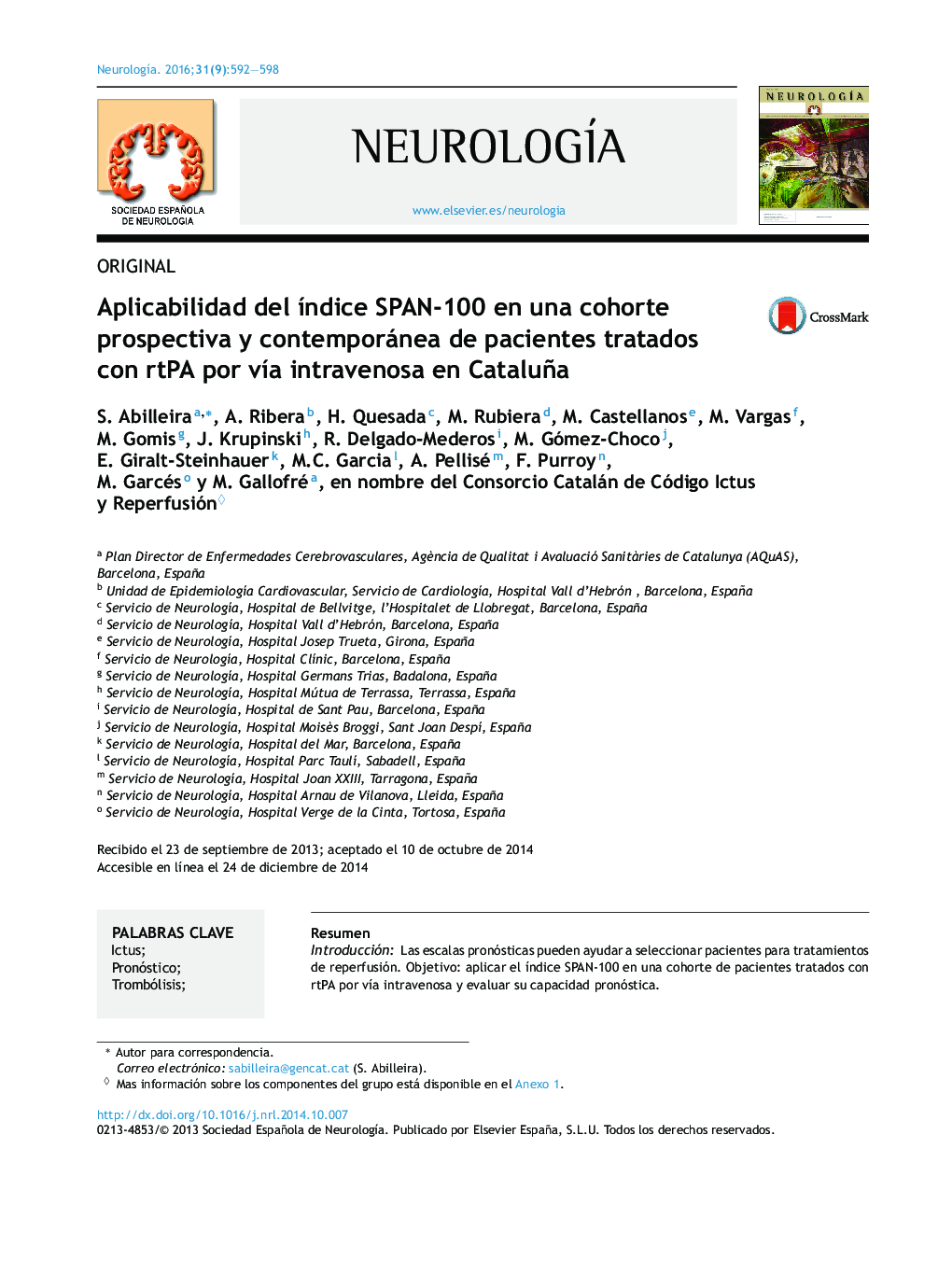| کد مقاله | کد نشریه | سال انتشار | مقاله انگلیسی | نسخه تمام متن |
|---|---|---|---|---|
| 5631834 | 1406514 | 2016 | 7 صفحه PDF | دانلود رایگان |

ResumenIntroducciónLas escalas pronósticas pueden ayudar a seleccionar pacientes para tratamientos de reperfusión. Objetivo: aplicar el Ãndice SPAN-100 en una cohorte de pacientes tratados con rtPA por vÃa intravenosa y evaluar su capacidad pronóstica.MétodosSe utilizaron datos del registro prospectivo de reperfusión de Cataluña y se seleccionaron casos consecutivos que recibieron rtPA por vÃa intravenosa aislado en 2011-2012. A partir del sumatorio de edad y NIHSS se categorizó la cohorte en SPAN-100 positivos [⥠100] y SPAN-100 negativos [< 100 puntos]. Se determinaron las tasas crudas y ajustadas de hemorragia sintomática (HICS), muerte e independencia funcional (ERm 0-2) a partir del Ãndice SPAN-100 y se calculó la curva ROC para la predicción de las principales medidas de resultado.ResultadosDe los 1.685 casos incluidos, 1.405 (83%) eran SPAN-100 negativos. La tasa de HICS ajustada por sexo, ERm preictus, hipertensión, diabetes, dislipemia, cardiopatÃa isquémica, insuficiencia cardÃaca, fibrilación auricular, ictus/AIT previos y tiempo hasta la trombólisis no fue diferente según las dos categorÃas pero la probabilidad de tener una ERm 0-2 al 3. er mes fue hasta casi 8 veces mayor entre los SPAN-100 negativos. El riesgo de muerte al 3. er mes fue 5 veces superior en los SPAN-100 positivos. El análisis ROC mostró especificidades altas tanto en la predicción de independencia funcional como mortalidad al 3. er mes cuando el punto de corte era de 100.ConclusionesEl Ãndice SPAN-100 es un Ãndice sencillo y de fácil aplicación que puede guiar la selección de pacientes para trombólisis cuando existen dudas razonables y asesorar al paciente/familia acerca de los resultados esperables.
BackgroundPrognostic scales can be helpful for selecting patients for reperfusion treatment. This study aims to assess the prognostic ability of the recently published SPAN-100 index in a large cohort of stroke patients treated with intravenous thrombolysis (IV rtPA).MethodsUsing data from the prospective registery of all reperfusion treatments administered in Catalonia, we selected patients treated with IV rtPA alone between 2011 and 2012. The SPAN-100 index was calculated as the sum of age (years) and NIHSS score, and patients in the cohort were classified as SPAN-100 positive [⥠100] or SPAN-100 negative [< 100]. We measured raw and adjusted rates of symptomatic intracerebral haemorrhage (SICH), mortality, and 3-month functional outcome (mRS 0-2) for each SPAN-100 category. Area under the ROC curve was calculated to predict the main outcome measures.ResultsWe studied 1685 rtPA-treated patients, of whom 1405 (83%) were SPAN-100 negative. The SICH rates adjusted for sex, pre-stroke mRS, hypertension, diabetes, dyslipidaemia, ischaemic heart disease, heart failure, atrial fibrillation, prior TIA/stroke and time to thrombolysis did not differ between groups, but likelihood of functional independence (mRS 0-2) at 3 months was nearly 8 times higher in the SPAN-100 negative group than in the positive group. Furthermore, the 3-month mortality rate was 5 times higher in the SPAN-100 positive group. ROC curve analysis showed high specificities for predicting both functional independence and 3-month mortality for a cut-off point of 100.ConclusionThe SPAN-100 index is a simple and straightforward method that may be useful for selecting candidates for rtPA treatment in doubtful cases, and for informing patients and their relatives about likely outcomes.
Journal: NeurologÃa - Volume 31, Issue 9, NovemberâDecember 2016, Pages 592-598